mirror controls JAGUAR S TYPE 2005 1.G Technical Guide Update
[x] Cancel search | Manufacturer: JAGUAR, Model Year: 2005, Model line: S TYPE, Model: JAGUAR S TYPE 2005 1.GPages: 133, PDF Size: 3.48 MB
Page 65 of 133
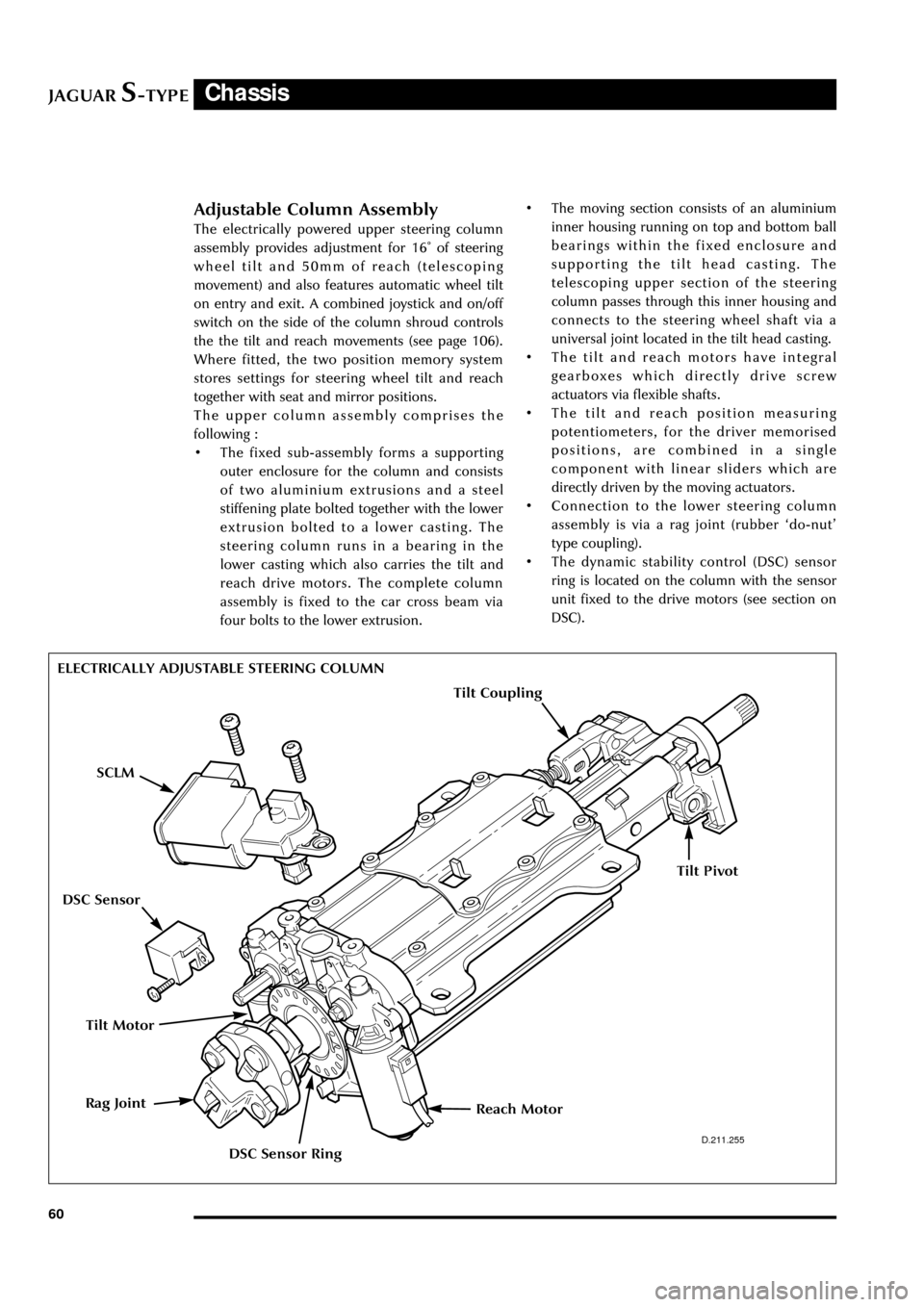
JAGUARS-TYPEChassis
60
D.211.255
ELECTRICALLY ADJUSTABLE STEERING COLUMN
Adjustable Column Assembly
The electrically powered upper steering column
assembly provides adjustment for 16û of steering
wheel tilt and 50mm of reach (telescoping
movement) and also features automatic wheel tilt
on entry and exit. A combined joystick and on/off
switch on the side of the column shroud controls
the the tilt and reach movements (see page 106).
Where fitted, the two position memory system
stores settings for steering wheel tilt and reach
together with seat and mirror positions.
The upper column assembly comprises the
following :
¥ The fixed sub-assembly forms a supporting
outer enclosure for the column and consists
of two aluminium extrusions and a steel
stiffening plate bolted together with the lower
extrusion bolted to a lower casting. The
steering column runs in a bearing in the
lower casting which also carries the tilt and
reach drive motors. The complete column
assembly is fixed to the car cross beam via
four bolts to the lower extrusion.¥ The moving section consists of an aluminium
inner housing running on top and bottom ball
bearings within the fixed enclosure and
supporting the tilt head casting. The
telescoping upper section of the steering
column passes through this inner housing and
connects to the steering wheel shaft via a
universal joint located in the tilt head casting.
¥ The tilt and reach motors have integral
gearboxes which directly drive screw
actuators via flexible shafts.
¥ The tilt and reach position measuring
potentiometers, for the driver memorised
positions, are combined in a single
component with linear sliders which are
directly driven by the moving actuators.
¥ Connection to the lower steering column
assembly is via a rag joint (rubber Ôdo-nutÕ
type coupling).
¥ The dynamic stability control (DSC) sensor
ring is located on the column with the sensor
unit fixed to the drive motors (see section on
DSC).
Tilt Motor
Reach MotorRag Joint
SCLM
DSC Sensor Ring
DSC Sensor
Tilt Coupling
Tilt Pivot
Page 68 of 133
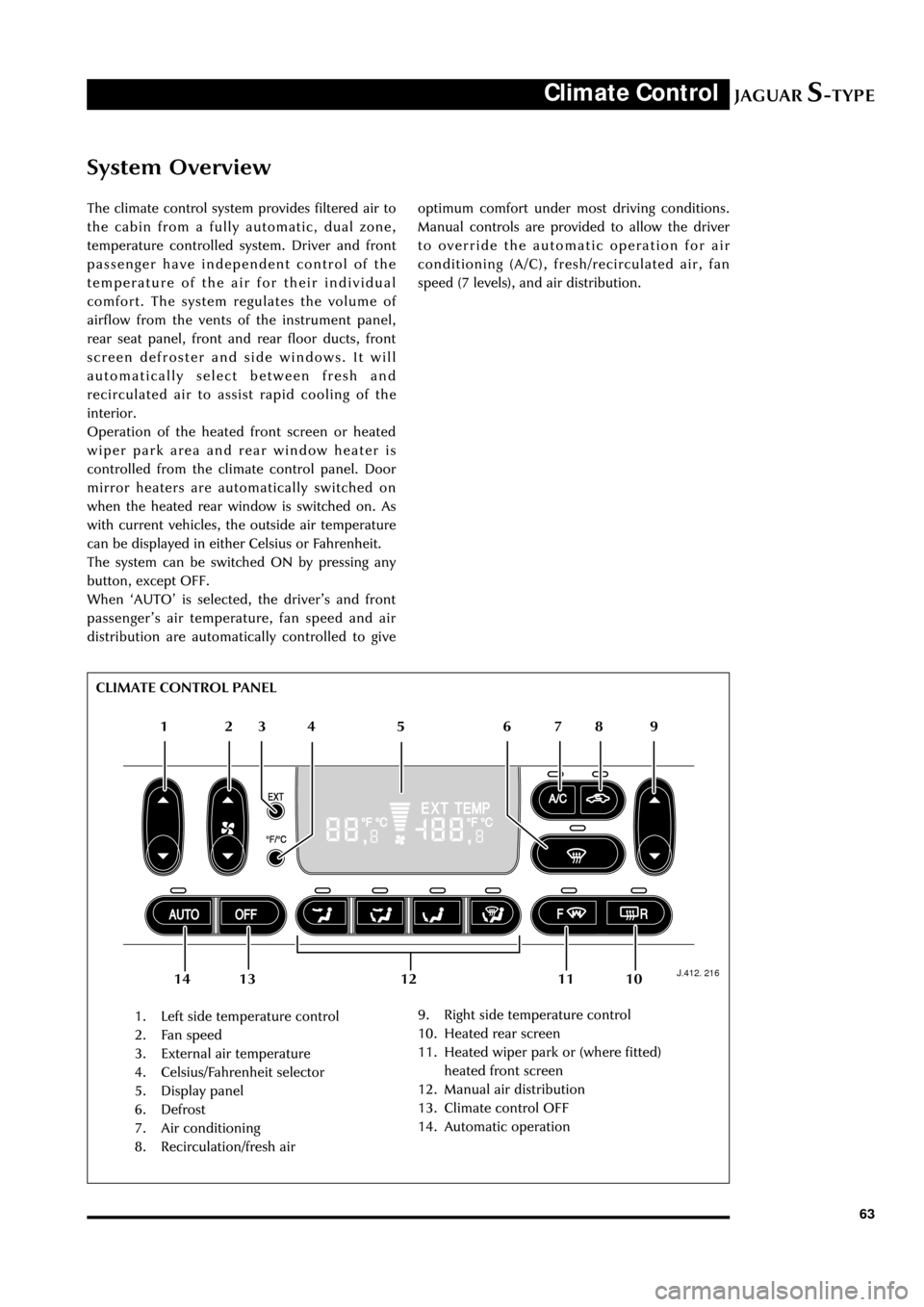
JAGUARS-TYPEClimate Control
63
System Overview
The climate control system provides filtered air to
the cabin from a fully automatic, dual zone,
temperature controlled system. Driver and front
passenger have independent control of the
temperature of the air for their individual
comfort. The system regulates the volume of
airflow from the vents of the instrument panel,
rear seat panel, front and rear floor ducts, front
screen defroster and side windows. It will
automatically select between fresh and
recirculated air to assist rapid cooling of the
interior.
Operation of the heated front screen or heated
wiper park area and rear window heater is
controlled from the climate control panel. Door
mirror heaters are automatically switched on
when the heated rear window is switched on. As
with current vehicles, the outside air temperature
can be displayed in either Celsius or Fahrenheit.
The system can be switched ON by pressing any
button, except OFF.
When ÔAUTOÕ is selected, the driverÕs and front
passengerÕs air temperature, fan speed and air
distribution are automatically controlled to give
J.412. 216
1. Left side temperature control
2. Fan speed
3. External air temperature
4. Celsius/Fahrenheit selector
5. Display panel
6. Defrost
7. Air conditioning
8. Recirculation/fresh air9. Right side temperature control
10. Heated rear screen
11. Heated wiper park or (where fitted)
heated front screen
12. Manual air distribution
13. Climate control OFF
14. Automatic operation optimum comfort under most driving conditions.
Manual controls are provided to allow the driver
to override the automatic operation for air
conditioning (A/C), fresh/recirculated air, fan
speed (7 levels), and air distribution.
12 65 4 3
109 8 7
11 13 12 14 CLIMATE CONTROL PANEL
Page 79 of 133

JAGUARS-TYPEElectrical/Electronic
74The SCP communication network will remain
operational even with severing of one of the bus
wires. Communications will also continue if one
of the bus wires is shorted to ground or battery
positive voltage (B+), or if some , but not all,
termination resistors are lost.
Unlike the SCP communication network, the
ISO 9141 communication network will not
function if the wire is shorted to ground or battery
positive voltage (B+). Also, if one of the modules
on the ISO 9141 network loses power or shorts
internally, communication to that module will fail.
Control Modules
The vehicle control module functions are
described briefly below (for further information
refer to the relevant sections throughout the
Guide).
Anti Lock Brake/Traction Control and
Dynamic Stability Control, Control Modules
The anti-lock brake control module is connected
to the SCP communication network. The module
comes in two forms. The first type is the standard
equipped anti-lock brake system (ABS) with
traction control (TC). It controls the brake
pressure to the four wheels to keep the vehicle
under control while braking.
The second type of ABS is optional and is called
dynamic stability control (DSC). This control
module adds yaw sensors to the package to help
in sensing a loss of vehicle control.
Audio Control Unit
The audio control unit is connected to the SCP
communication network and also to the audio
control protocol (ACP) communication network.
The audio control unit communicates with the
compact disc and the cellular phone transceiver.
Driver Door Control Module (DDCM)
DDCM is connected to the SCP communication
network. The module controls many functions
including power windows, driver mirror, power
locks, and keyless remote entry.Driver Seat Control Module (DSCM)
The DSCM is connected to the SCP
communication network. The DSCM is located
under the driver seat and controls the seat
positions. The module also communicates with the
DDCM to control the driver seat memory
functions.
Control Module Locations
Key to illustration on following page:
1.Anti-lock brake system/Traction control
system or Dynamic stability control
(ABS/TCCM or DSCCM)
(non-handed)
2.Throttle actuator control module (TACM)
(non-handed)
3.Powertrain control module (PCM) (handed)
4.Air conditioning control module (A/CCM)
(non-handed)
5.Restraint control module (RCM) (non-handed)
6.Sliding roof control module (SRCM)
(non-handed)
7.Passenger seat heater control module
(PSHCM) (non-handed)
8.Rear electronic control module (RECM)
(non-handed)
9.Vehicle information control module (VICM)
(Japan only)
10.Adaptive damping control module (ADCM)
(non-handed)
11.Parking aid control module (PACM)
(non-handed)
12.Navigation control module (NCM)
(non-handed)
13.Vehicle emergency control module (VECM)
(non-handed)
14.Voice-activated control module (VACM)
(non-handed)
15.Cellular telephone control module (CTCM)
(non-handed)
16.Driver seat heater control module (DSHCM)
(non-handed)
17.Driver seat control module (DSCM) (handed)
18.Driver door control module (DDCM)
(handed)
19.Instrument pack (handed)
20.General electronics control module (GECM)
(non-handed)
21.Steering column lock module (SCLM) (handed)
Page 81 of 133
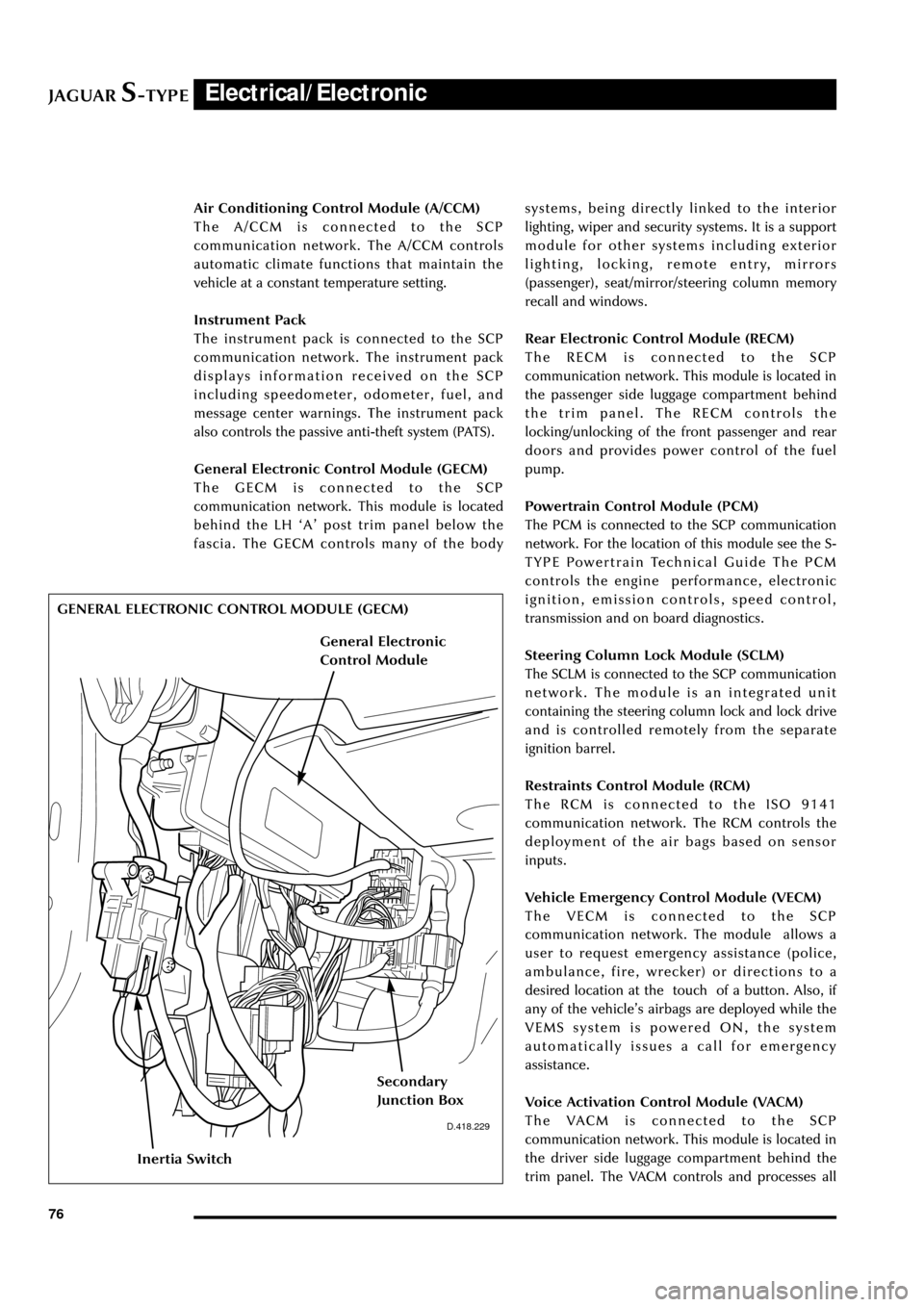
JAGUARS-TYPEElectrical/Electronic
76Air Conditioning Control Module (A/CCM)
The A/CCM is connected to the SCP
communication network. The A/CCM controls
automatic climate functions that maintain the
vehicle at a constant temperature setting.
Instrument Pack
The instrument pack is connected to the SCP
communication network. The instrument pack
displays information received on the SCP
including speedometer, odometer, fuel, and
message center warnings. The instrument pack
also controls the passive anti-theft system (PATS).
General Electronic Control Module (GECM)
The GECM is connected to the SCP
communication network. This module is located
behind the LH ÔAÕ post trim panel below the
fascia. The GECM controls many of the bodysystems, being directly linked to the interior
lighting, wiper and security systems. It is a support
module for other systems including exterior
lighting, locking, remote entry, mirrors
(passenger), seat/mirror/steering column memory
recall and windows.
Rear Electronic Control Module (RECM)
The RECM is connected to the SCP
communication network. This module is located in
the passenger side luggage compartment behind
the trim panel. The RECM controls the
locking/unlocking of the front passenger and rear
doors and provides power control of the fuel
pump.
Powertrain Control Module (PCM)
The PCM is connected to the SCP communication
network. For the location of this module see the S-
TYPE Powertrain Technical Guide The PCM
controls the engine performance, electronic
ignition, emission controls, speed control,
transmission and on board diagnostics.
Steering Column Lock Module (SCLM)
The SCLM is connected to the SCP communication
network. The module is an integrated unit
containing the steering column lock and lock drive
and is controlled remotely from the separate
ignition barrel.
Restraints Control Module (RCM)
The RCM is connected to the ISO 9141
communication network. The RCM controls the
deployment of the air bags based on sensor
inputs.
Vehicle Emergency Control Module (VECM)
The VECM is connected to the SCP
communication network. The module allows a
user to request emergency assistance (police,
ambulance, fire, wrecker) or directions to a
desired location at the touch of a button. Also, if
any of the vehicleÕs airbags are deployed while the
VEMS system is powered ON, the system
automatically issues a call for emergency
assistance.
Voice Activation Control Module (VACM)
The VACM is connected to the SCP
communication network. This module is located in
the driver side luggage compartment behind the
trim panel. The VACM controls and processes all
D.418.229
GENERAL ELECTRONIC CONTROL MODULE (GECM)
Inertia Switch
Secondary
Junction Box
General Electronic
Control Module
Page 99 of 133
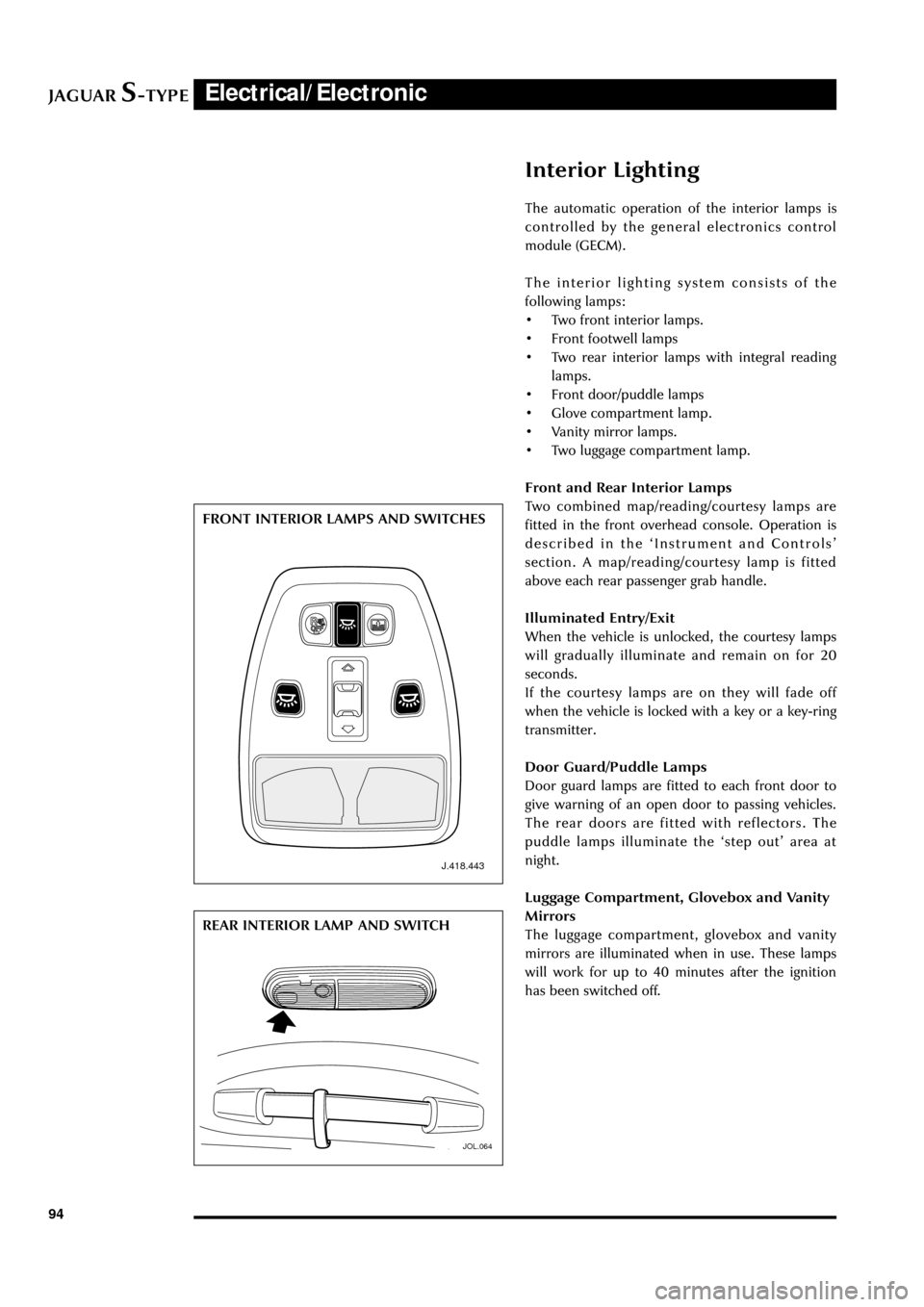
JAGUARS-TYPEElectrical/Electronic
94
Interior Lighting
The automatic operation of the interior lamps is
controlled by the general electronics control
module (GECM).
The interior lighting system consists of the
following lamps:
¥ Two front interior lamps.
¥ Front footwell lamps
¥ Two rear interior lamps with integral reading
lamps.
¥ Front door/puddle lamps
¥ Glove compartment lamp.
¥ Vanity mirror lamps.
¥ Two luggage compartment lamp.
Front and Rear Interior Lamps
Two combined map/reading/courtesy lamps are
fitted in the front overhead console. Operation is
described in the ÔInstrument and ControlsÕ
section. A map/reading/courtesy lamp is fitted
above each rear passenger grab handle.
Illuminated Entry/Exit
When the vehicle is unlocked, the courtesy lamps
will gradually illuminate and remain on for 20
seconds.
If the courtesy lamps are on they will fade off
when the vehicle is locked with a key or a key-ring
transmitter.
Door Guard/Puddle Lamps
Door guard lamps are fitted to each front door to
give warning of an open door to passing vehicles.
The rear doors are fitted with reflectors. The
puddle lamps illuminate the Ôstep outÕ area at
night.
Luggage Compartment, Glovebox and Vanity
Mirrors
The luggage compartment, glovebox and vanity
mirrors are illuminated when in use. These lamps
will work for up to 40 minutes after the ignition
has been switched off.
J.418.443
JOL.064
FRONT INTERIOR LAMPS AND SWITCHES
REAR INTERIOR LAMP AND SWITCH
Page 107 of 133
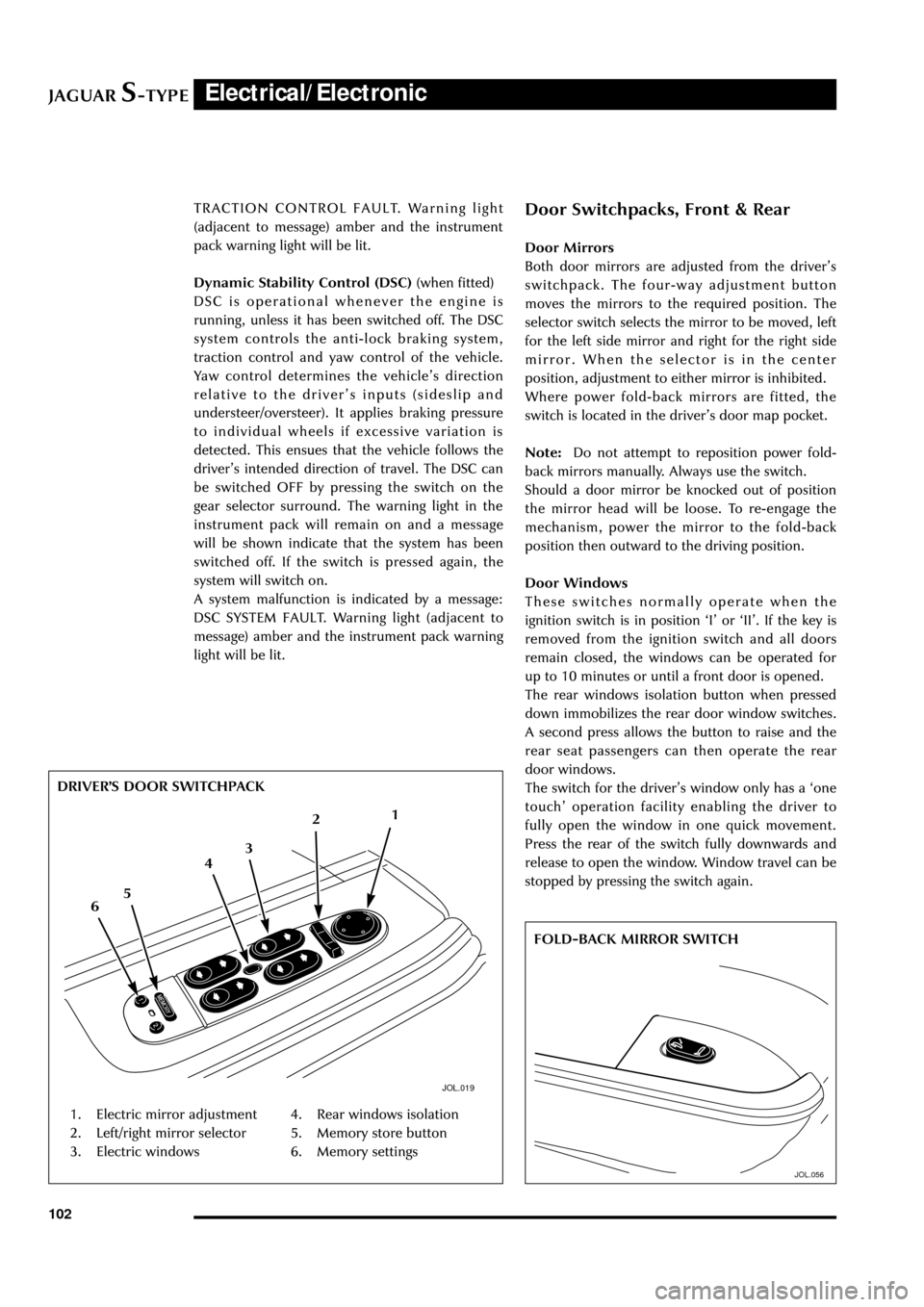
JAGUARS-TYPEElectrical/Electronic
102
Door Switchpacks, Front & Rear
Door Mirrors
Both door mirrors are adjusted from the driverÕs
switchpack. The four-way adjustment button
moves the mirrors to the required position. The
selector switch selects the mirror to be moved, left
for the left side mirror and right for the right side
mirror. When the selector is in the center
position, adjustment to either mirror is inhibited.
Where power fold-back mirrors are fitted, the
switch is located in the driverÕs door map pocket.
Note:Do not attempt to reposition power fold-
back mirrors manually. Always use the switch.
Should a door mirror be knocked out of position
the mirror head will be loose. To re-engage the
mechanism, power the mirror to the fold-back
position then outward to the driving position.
Door Windows
These switches normally operate when the
ignition switch is in position ÔIÕ or ÔIIÕ. If the key is
removed from the ignition switch and all doors
remain closed, the windows can be operated for
up to 10 minutes or until a front door is opened.
The rear windows isolation button when pressed
down immobilizes the rear door window switches.
A second press allows the button to raise and the
rear seat passengers can then operate the rear
door windows.
The switch for the driverÕs window only has a Ôone
touchÕ operation facility enabling the driver to
fully open the window in one quick movement.
Press the rear of the switch fully downwards and
release to open the window. Window travel can be
stopped by pressing the switch again. TRACTION CONTROL FAULT. Warning light
(adjacent to message) amber and the instrument
pack warning light will be lit.
Dynamic Stability Control (DSC) (when fitted)
DSC is operational whenever the engine is
running, unless it has been switched off. The DSC
system controls the anti-lock braking system,
traction control and yaw control of the vehicle.
Yaw control determines the vehicleÕs direction
relative to the driverÕs inputs (sideslip and
understeer/oversteer). It applies braking pressure
to individual wheels if excessive variation is
detected. This ensues that the vehicle follows the
driverÕs intended direction of travel. The DSC can
be switched OFF by pressing the switch on the
gear selector surround. The warning light in the
instrument pack will remain on and a message
will be shown indicate that the system has been
switched off. If the switch is pressed again, the
system will switch on.
A system malfunction is indicated by a message:
DSC SYSTEM FAULT. Warning light (adjacent to
message) amber and the instrument pack warning
light will be lit.
JOL.019
1. Electric mirror adjustment
2. Left/right mirror selector
3. Electric windows4. Rear windows isolation
5. Memory store button
6. Memory settings DRIVERÕS DOOR SWITCHPACK
1
2
6543
JOL.056
FOLD-BACK MIRROR SWITCH